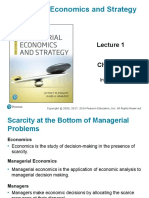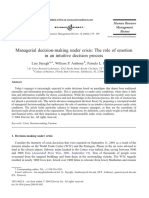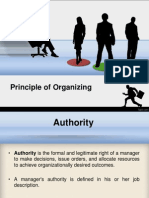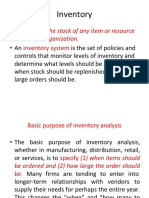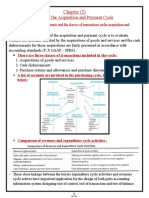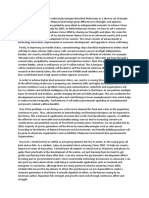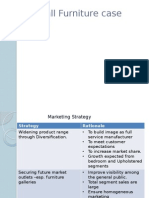100%(1)100% found this document useful (1 vote)
95 viewsAssignment# 5: You Are Kindly Requested To Apply The 4 Function of
Assignment# 5: You Are Kindly Requested To Apply The 4 Function of
Uploaded by
Mustafa DeebThe document discusses applying the four functions of management (planning, organizing, leading, controlling) to a department in order to achieve its objectives. Planning involves analyzing internal/external factors to set goals. Organizing assembles resources like people, money, tools to achieve goals. Leading motivates employees and gets them onboard with the plan. Controlling installs processes to guide progress toward goals and allows making adjustments.
Copyright:
© All Rights Reserved
Available Formats
Download as DOCX, PDF, TXT or read online from Scribd
Assignment# 5: You Are Kindly Requested To Apply The 4 Function of
Assignment# 5: You Are Kindly Requested To Apply The 4 Function of
Uploaded by
Mustafa Deeb100%(1)100% found this document useful (1 vote)
95 views4 pagesThe document discusses applying the four functions of management (planning, organizing, leading, controlling) to a department in order to achieve its objectives. Planning involves analyzing internal/external factors to set goals. Organizing assembles resources like people, money, tools to achieve goals. Leading motivates employees and gets them onboard with the plan. Controlling installs processes to guide progress toward goals and allows making adjustments.
Original Title
Assignment #5
Copyright
© © All Rights Reserved
Available Formats
DOCX, PDF, TXT or read online from Scribd
Share this document
Did you find this document useful?
Is this content inappropriate?
The document discusses applying the four functions of management (planning, organizing, leading, controlling) to a department in order to achieve its objectives. Planning involves analyzing internal/external factors to set goals. Organizing assembles resources like people, money, tools to achieve goals. Leading motivates employees and gets them onboard with the plan. Controlling installs processes to guide progress toward goals and allows making adjustments.
Copyright:
© All Rights Reserved
Available Formats
Download as DOCX, PDF, TXT or read online from Scribd
Download as docx, pdf, or txt
100%(1)100% found this document useful (1 vote)
95 views4 pagesAssignment# 5: You Are Kindly Requested To Apply The 4 Function of
Assignment# 5: You Are Kindly Requested To Apply The 4 Function of
Uploaded by
Mustafa DeebThe document discusses applying the four functions of management (planning, organizing, leading, controlling) to a department in order to achieve its objectives. Planning involves analyzing internal/external factors to set goals. Organizing assembles resources like people, money, tools to achieve goals. Leading motivates employees and gets them onboard with the plan. Controlling installs processes to guide progress toward goals and allows making adjustments.
Copyright:
© All Rights Reserved
Available Formats
Download as DOCX, PDF, TXT or read online from Scribd
Download as docx, pdf, or txt
You are on page 1of 4
Assignment# 5: You are kindly requested to apply the 4 function of
management on a department and show it will implement each
function in order to achieve the objective of the department.
Four functions of management
Managers typically perform the four overarching functions of
planning, organizing, leading, and controlling. these four functions
can be performed that will increase employee trust in their
supervisors, which will, in turn, have positive implications for the
organizations.
These are “the how” a manager pursues organizational goals, and
are universally known as the four functions of management. We use
the term leading instead of these practices.
1. Planning is the systematic process of making decisions about
goals and activities the organization will pursueTo make a
decision about the direction of an organization, the planning
phase must begin with analyzing the environment. Without a
solid understanding of the context, the manager would have
no basis to provide future direction. The context gives a
manager a point of reference for improvement, opportunity,
and learning from past mistakes. For this reason, the planning
function should begin with analysis. This analysis should
consider both the internal factors such as culture, values, and
performance of team members as well as the external factors
such as competitive environment, legal, regulations, economy,
technology, social values, and demographics.
The second component of planning is to use this analysis of
the environment to build goals, activities, and objectives. For
a major organization this might be the vision and mission
statement of the organization. For a smaller organization this
could be a year end, or season end goal. Some consider
planning that point in your day or month that you step away
from your desk, and think about the direction of your
organization. This requires you to reflect on your
organization’s past, and determine how that impacts the
direction going forward.
2. Organizing is the process of assembling and assigning the
human, financial, physical, informational, and other resources
needed to achieve goals. The core of the organizing function is
leveraging the resources to align with the determined goals.
Organizing human resources means first of all attracting a
labor force that can help you pursue your goal. Within the
organization, managing the human element means assigning
tasks, delegating authority, determining a structure and
hierarchy. Organizing the financial resources equates to
making sure your capital is being utilized to meet goals. If an
organization decides they want to have a best-in-class
customer service team, they better being willing to spend the
money to attract people with the disposition towards serving
others, and spend money on training, or a retreat to teach the
agents the skillsets they need. Connecting employees to how
they contribute to the financial bottom line is a way of
leveraging informational resources, as is using your company’s
proprietary algorithm to predict stock prices or develop new
products.
3. Leading is stimulating high performance by members of the
organization. This function is getting members of the
organization on board with the plan. Normally, this means
connecting with direct reports or teammates on a personal
level. Understanding what drives individuals within the team
allows a manager to design strategies around motivating,
incentivizing, mobilizing, and arousing a desire to contribute.
Implemented the planning and organizing functions. In this
scenario, however, you did not give consideration to how your
team or organization would be involved. Do they agree with
your direction? Did they have input in the process? Do they
feel valued as a team member? Do they understand their role
in a successful outcome? All of these questions are answered
by the degree to which a manager is engaged in the leading
function. Having personal conversations, designing a bonus
structure, or giving a rousing speech might all be considered
leading the organization.
4. Control is installing processes to guide the team towards goals
and monitoring performance towards goals and making
changes to the plan as needed. Control does not always mean
limited what the organization can do by having a hand in
everything. We might call this micro-managing, which is
control in its extreme form. Healthy control processes involve
putting systems in place to make sure your organization is on
track to meet the goals you established in the planning
process. Planning sets standards to compare against, and the
control process is the dashboard that tells whether or not you
are meeting the standard. For example, a grocery store might
set a goal of reducing shrink (that’s product lost to shoplifting,
damage). They decide that they want to reduce their shrink
loss by 50%. To achieve this plan, they will have to dedicate
resources (more employees to monitor, rearrange loading
dock). You already recognize that step as the organizing
function. We then incentivize our employees by designing a
bonus structure – i.e. if we collectively meet the goal, each
employee shares in the savings. If we stop there, we would
have no way of knowing if we met the goal. The control
process solves this for us. The last step in the grocery store
manager’s managerial approach is to have each department
head report their shrink loss at the end of the shift, and
aggregate those in an excel spreadsheet. In this way, the
manager can see if the rearrangement of the loading dock has
reduced the number of damaged canned goods that was
happening under the old arrangement. The manager can
make changes if they see that shrink is not improving even
after hiring a greeter at the entrance.
You might also like
- Ethics CourseworkDocument5 pagesEthics CourseworkJanice WooNo ratings yet
- Productivity and Reliability-Based Maintenance Management, Second EditionFrom EverandProductivity and Reliability-Based Maintenance Management, Second EditionNo ratings yet
- Managerial Economics and Strategy: Third EditionDocument17 pagesManagerial Economics and Strategy: Third EditionNanthakumar SubramanianNo ratings yet
- Case Study 6 - Schneider National Keeps On Trucking With Communications TechnologyDocument3 pagesCase Study 6 - Schneider National Keeps On Trucking With Communications TechnologyMUHAMMAD RAFIQ100% (1)
- Kenya Institute of Management (Kim) DBM 635: Strategic Business Management Instructor: MR Alex ChegeDocument7 pagesKenya Institute of Management (Kim) DBM 635: Strategic Business Management Instructor: MR Alex ChegeCollins AbereNo ratings yet
- Controlling (Principles of Management)Document17 pagesControlling (Principles of Management)kiedd_04100% (1)
- Constraints On Growth & Productivity - Efficiency of Capacity UtlisationDocument14 pagesConstraints On Growth & Productivity - Efficiency of Capacity UtlisationAppan Kandala VasudevacharyNo ratings yet
- The Four Functions of ManagementDocument3 pagesThe Four Functions of ManagementMark Elben100% (1)
- Operations Research Concepts and ConventionsDocument15 pagesOperations Research Concepts and ConventionsmathiasNo ratings yet
- Handout 03 Continuous Random VariablesDocument18 pagesHandout 03 Continuous Random Variablesmuhammad ali100% (1)
- Queuing and PERTDocument6 pagesQueuing and PERTTyronNo ratings yet
- The Integration of TQM and BPRDocument18 pagesThe Integration of TQM and BPRdawit melkamuNo ratings yet
- EG 3336 E / 6333 A Operations Research II Spring 2009 Homework Assignment #1 Due: at 6:30 PM in Class On Monday February 09, 2009Document2 pagesEG 3336 E / 6333 A Operations Research II Spring 2009 Homework Assignment #1 Due: at 6:30 PM in Class On Monday February 09, 2009ArticleDownloaderNo ratings yet
- Introduction ManagmentDocument175 pagesIntroduction Managmentbarke100% (1)
- Managing People in Technology-Based Organizations IssuesDocument23 pagesManaging People in Technology-Based Organizations IssuesRhea Daluddung Sanchez100% (1)
- Project Management Ch1Document14 pagesProject Management Ch1araml001100% (1)
- 10 Types of Information SystemsDocument6 pages10 Types of Information SystemsAmina AjemaNo ratings yet
- What Is Maintenance ExcellenceDocument3 pagesWhat Is Maintenance ExcellenceCesar Montes De Oca100% (3)
- Importance of Project Management in Modern Business World2222 PDFDocument8 pagesImportance of Project Management in Modern Business World2222 PDFShuvo HoqueNo ratings yet
- Turban Dss9e ch01 PDFDocument75 pagesTurban Dss9e ch01 PDFxdreamahNo ratings yet
- Suite8 How To Manual V8.9Document215 pagesSuite8 How To Manual V8.9Ala K ObeigNo ratings yet
- Management ConceptDocument12 pagesManagement ConceptMurugesa PandianNo ratings yet
- Managerial Decision Making Under CrisisDocument21 pagesManagerial Decision Making Under CrisisAdrienn Mathe0% (1)
- 1 Slide © 2005 Thomson/South-WesternDocument70 pages1 Slide © 2005 Thomson/South-WesternNad IraNo ratings yet
- Operations Research NotesDocument73 pagesOperations Research NotesShivam kesarwani100% (1)
- Organizational Behaviour Only AssignmentDocument9 pagesOrganizational Behaviour Only AssignmentpiloNo ratings yet
- Management Support SystemsDocument13 pagesManagement Support SystemserangadddNo ratings yet
- Game TheoryDocument12 pagesGame TheoryTrang CaoNo ratings yet
- Human Resource Department Functions in State Bank of PakistanDocument72 pagesHuman Resource Department Functions in State Bank of PakistanInfinityIcon100% (3)
- K-Means ClusteringDocument6 pagesK-Means Clusteringhifzan786No ratings yet
- Who Has The D Summary by AdeelDocument3 pagesWho Has The D Summary by AdeelSadiaSadi0% (1)
- Entrepreneurial Mind PPT Green Management 2Document15 pagesEntrepreneurial Mind PPT Green Management 2Denice Natalie RepiqueNo ratings yet
- Strategic Roles of Procurement Its GrowtDocument21 pagesStrategic Roles of Procurement Its GrowtS Gord100% (1)
- Chapter 1 - Individual Exercise: Additional Cases and Worked SolutionsDocument4 pagesChapter 1 - Individual Exercise: Additional Cases and Worked Solutionsshaikha alneyadiNo ratings yet
- Introduction To Organizational Behavior: Mcgraw-Hill/IrwinDocument49 pagesIntroduction To Organizational Behavior: Mcgraw-Hill/IrwinKareem RasmyNo ratings yet
- 11-3. What Are The Major Types of Knowledge Work Systems, and How They Provides Value For Firms?Document3 pages11-3. What Are The Major Types of Knowledge Work Systems, and How They Provides Value For Firms?Dodi PrasetyaNo ratings yet
- Chap3 Risk AnalysisDocument40 pagesChap3 Risk AnalysispallaviingaleNo ratings yet
- A Multi-Objective Programming Model For SchedulingDocument14 pagesA Multi-Objective Programming Model For SchedulingSaharani Abdul RashidNo ratings yet
- Strategic Planning Process and Background References PDFDocument11 pagesStrategic Planning Process and Background References PDFMarmie CamayangNo ratings yet
- Chapter 7 Inferences Using Normal and T-DistributionDocument16 pagesChapter 7 Inferences Using Normal and T-Distributionmenglee100% (1)
- Mid Term Problem 1 & 2-1-54877Document2 pagesMid Term Problem 1 & 2-1-54877Nehal NabilNo ratings yet
- SimulationDocument33 pagesSimulationHIRWA YVAN MVUNABONo ratings yet
- Chapter 4 and 5: Responsibility CentersDocument30 pagesChapter 4 and 5: Responsibility CentersRajat SharmaNo ratings yet
- Chapter 2 - Engineering ManagementDocument6 pagesChapter 2 - Engineering ManagementJohn Philip Molina NuñezNo ratings yet
- CH 13: Building Information Systems: LO 13.1 - How Does Building New Systems Produce Organizational Change?Document2 pagesCH 13: Building Information Systems: LO 13.1 - How Does Building New Systems Produce Organizational Change?Asora Yasmin snehaNo ratings yet
- Discuss One Current Issue in Operations ManagementDocument3 pagesDiscuss One Current Issue in Operations ManagementFariha Shams Butt100% (1)
- Heizer 01Document107 pagesHeizer 01sabinaa20No ratings yet
- Belassi Tukel A New Framework For Determining Critical Successfailure Factors in ProjectsDocument11 pagesBelassi Tukel A New Framework For Determining Critical Successfailure Factors in Projectsfranckiko2No ratings yet
- ConvolutionDocument23 pagesConvolutionsubbu2051No ratings yet
- Functions of ManagementDocument13 pagesFunctions of ManagementLemi Chala Beyene100% (1)
- Principle of OrganizingDocument15 pagesPrinciple of Organizingeshaprashar88No ratings yet
- Mount Kenya University Bed 1101: Introduction To Micro-Economics Cat I Name: Abdikadir Osman Edin REG - NO: BOP/2020/63138Document5 pagesMount Kenya University Bed 1101: Introduction To Micro-Economics Cat I Name: Abdikadir Osman Edin REG - NO: BOP/2020/63138Elias BonkeNo ratings yet
- Effective Managerial DecisionsDocument39 pagesEffective Managerial DecisionsAlvin Samonte100% (1)
- Handout-03 Decision MakingDocument4 pagesHandout-03 Decision Makingncnc100% (1)
- Marketing Management U 1Document27 pagesMarketing Management U 1Sana KhursheedNo ratings yet
- Chapter 1 & 2 CompleteDocument81 pagesChapter 1 & 2 CompleteAmanda DrainvilleNo ratings yet
- What Is Operations Management - A Simple: Manager DoDocument7 pagesWhat Is Operations Management - A Simple: Manager DoJoshua Tala-ocNo ratings yet
- ACT 102 For Students'Document10 pagesACT 102 For Students'Jomair GuroNo ratings yet
- QuestionBank For Management Control SystemDocument4 pagesQuestionBank For Management Control SystemAmrita PatilNo ratings yet
- Assignment #8Document6 pagesAssignment #8Mustafa DeebNo ratings yet
- Assignment #3: You Are Kindly Requested To Apply The 4 Different Cases On The Productivity Dimensions On An Organization and Explain Each ScenarioDocument4 pagesAssignment #3: You Are Kindly Requested To Apply The 4 Different Cases On The Productivity Dimensions On An Organization and Explain Each ScenarioMustafa DeebNo ratings yet
- Assignment #9Document7 pagesAssignment #9Mustafa DeebNo ratings yet
- Assignment #1Document5 pagesAssignment #1Mustafa DeebNo ratings yet
- InventoryDocument83 pagesInventoryAbdul AzizNo ratings yet
- 4249CDAEE74065E3Document2 pages4249CDAEE74065E3Zain Ahmed MalikNo ratings yet
- The Demand Function For Product X Is Given byDocument8 pagesThe Demand Function For Product X Is Given byAnderson AliNo ratings yet
- Shrimp FarmingDocument2 pagesShrimp FarmingNaina Pradeep singhNo ratings yet
- Presentation1 (Autosaved) Module 11-ConDocument18 pagesPresentation1 (Autosaved) Module 11-Conclara dupitasNo ratings yet
- Auditing 4 Chapter 1Document19 pagesAuditing 4 Chapter 1Mohamed Diab100% (1)
- Ras Mains SyllabusDocument10 pagesRas Mains Syllabus9782279059No ratings yet
- CH9-Cost MGMTDocument8 pagesCH9-Cost MGMTSubramanian RamakrishnanNo ratings yet
- Presented By-:: Neelesh Shrivastava Nikhil Sood Nitin Malik Omansh Bhardwaj Mohd ArmanDocument30 pagesPresented By-:: Neelesh Shrivastava Nikhil Sood Nitin Malik Omansh Bhardwaj Mohd ArmanARMAN PILOTNo ratings yet
- Probability Concept and Application (Exercise Answer)Document14 pagesProbability Concept and Application (Exercise Answer)LokaNo ratings yet
- HR AvanceonDocument4 pagesHR Avanceontariqfast12No ratings yet
- A Project of Market Plan On "Unilever Pakistan": Operations ManagementDocument24 pagesA Project of Market Plan On "Unilever Pakistan": Operations ManagementJawadNo ratings yet
- Esope. 2004.Document146 pagesEsope. 2004.SERKAN DİKNo ratings yet
- CG Question 567Document1 pageCG Question 567Maryam MalikNo ratings yet
- Chapter 2Document3 pagesChapter 2Hannah Lane SubongNo ratings yet
- Tommy Hilfiger Terms and Conditions AgreementDocument2 pagesTommy Hilfiger Terms and Conditions AgreementWilmerfredNo ratings yet
- Chapter 2 - Asset Classes and Financial Instruments NewDocument25 pagesChapter 2 - Asset Classes and Financial Instruments NewBùi Thái SơnNo ratings yet
- English Essay Vision 2050 (TN50)Document2 pagesEnglish Essay Vision 2050 (TN50)Piragalathan Thirunavukkarasu100% (1)
- What Is It? Wich Accounts or Information It Contains? What Is Used For? It Is Used To Report A CompanysDocument1 pageWhat Is It? Wich Accounts or Information It Contains? What Is Used For? It Is Used To Report A CompanysRenatoMoraNo ratings yet
- Marketing ControlDocument22 pagesMarketing ControlrathnakotariNo ratings yet
- Tyndall Furniture Case Study - ThroughputDocument13 pagesTyndall Furniture Case Study - ThroughputSoma Sundaram100% (1)
- Wedding R UsDocument5 pagesWedding R UsAnnie Clado San JuanNo ratings yet
- Production Economics and Marketing of Mud Crabs in The PhilippinesDocument10 pagesProduction Economics and Marketing of Mud Crabs in The PhilippinesKelvinmartin PoseranNo ratings yet
- BM1706 Intermediate Accounting 1Document8 pagesBM1706 Intermediate Accounting 1Mark Anthony Llovit BabaoNo ratings yet
- Project Report On Vizag Steel Plant Distribution ChannelDocument91 pagesProject Report On Vizag Steel Plant Distribution ChannelPrisin Sudakaran0% (1)
- HRM 1Document22 pagesHRM 1sanzit100% (1)
- Equity4life - IPO SetupDocument10 pagesEquity4life - IPO SetupmathnetindiaNo ratings yet
- Chapter 6: Entry and Exit Questions and Problems AnswerDocument6 pagesChapter 6: Entry and Exit Questions and Problems AnswerJabed Faruk100% (2)
- Complete English Batch Reading Comprehension: English by Vishal PariharDocument35 pagesComplete English Batch Reading Comprehension: English by Vishal PariharKartik VermaNo ratings yet
- About The Student: This Se Ction A Sks For Importa NT Informa Tion A Bout The Stude NTDocument11 pagesAbout The Student: This Se Ction A Sks For Importa NT Informa Tion A Bout The Stude NTtop5 nepalNo ratings yet


